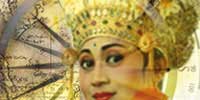|
DENPASAR (indo.com): Traditional textiles are hand woven
works of arts, requiring a tremendous amount of skill and
time. They are also highly valuable cultural artifacts,
widely sought-after by collectors and institutions.
The traditional textiles of Indonesia, particularly old
ones, have long been of interest to art-collectors and academics
alike. Prized for their stunning beauty and essential cultural
function, these works of art are perhaps the most meaningful
objects to acquire in Bali.
Perhaps some of you have showed Rangda and Barong Dances
in Bali or on television. You could see that the dancers
wears a special red cloth wound around his hips to protect
him from the overwhelming powers at works. It is kain cepuk,
a hand woven ikat cloth from Nusa Penida that serves as
the barrier between human soul and bedlam. It shows that
cloth has more than strands of thread woven together.
In Bali textiles are everywhere. Religious paraphernalia,
shrines, dancers, priests, masks, and animals to be sacrificed
will be wrapped, bound, draped or ornamented with specifically
prescribed textiles, redolent with symbolic meaning. Bali
has no means unique in this regard.
Throughout Indonesia, traditional textiles are more that
mere objects. Textiles are perhaps the most significant
single art form in the archipelago. As well as Bali, they
are also ritual objects, stored wealth, trade goods, and
tokens of power.
The Batak People has the ulos ragidup which literally means
cloth of life. It is a composition of sombretoned cotton,
worn by rajas, and used in major life transition rituals.
Its end panels contain weird geometric diagrams, which can
be "read" by shamans, for the purpose of divination.
In many regions, heirloom textiles are required gifts during
wedding ceremonies, symbolically connecting the clans of
the bridge and groom. On Lembata Island off the coast of
Timor, when asked what they would do without their bread
wealth textiles women answered, "Without the cloth we cannot
marry." If these women did not marry, their culture would
soon be extinct.
That is how essential textiles can be in Indonesia, and
they are therefore woven with extraordinary care and attention,
on both a visible and invisible level.
 |
| The famous double Ikat
Geringsing from Tenganan village in Karangasem derives
from the double ikat patola of West India. The ethnically
unique people of Tenganan claim to be directly descended
from India. |
|
| |
|
Many Indonesian textiles are colored with organic dyestuff,
which requires meticulous care. The dyeing process ensures
a successful outcome. Like the alchemists of medieval workers
of magic, and formulas, processes and rituals are closely
guarded secrets.
Among the Iban people in Kalimantan, while warfare is the
domain of men, weaving is 'the women's warpath'. Ritual
textiles are women's contributions to the martial efforts,
and closely related spiritual life of the community. The
intensely powerful human, animal, and mythological figures
in Iban cloths are imparted to the weavers in dreams, and
so belong to mystical realm.
Just a suggestion, you don't have to scour the far corners
of the Indonesia to find top quality traditional textiles
at good prices. Bali has become the marketplace for antique
textiles, almost from all over the archipelago. In fact,
you will probably do better in Bali, because there is more
selection in one place and often better prices.
For self-guarantee satisfaction, try the Galleries at five-star
hotels, and then visit antique shops in Ubud, Kuta and Nusa
Dua. In reputable galleries you commonly get what you pay
for. (Bali Echo)
|







